Art Deco Illinois: A Short Tour of the Architectural Wonders Found All Across The Prairie State
Illinois Week on Atlas Obscura was created in partnership with Enjoy Illinois as part of the launch of the new Illinois Obscura Society. Sign up to find out more about the back room tours, unusual adventures, and incredible parties that Atlas Obscura will be putting on in Chicago and greater Illinois.

National Guard Armory, Champaign, Illinois (Photo by Tau Zero/Flickr)
Most people are no stranger to Art Deco. The early 20th century design movement flourished between the two World Wars and came to symbolize the world’s dreams of a bright modern future. However most people simply associate the style with its metropolis exemplars – skyscrapers of New York, apartment blocks in Miami, buildings throughout Chicago. But the Art Deco movement left its stamp in more places than just the big cities. Here in Illinois, there are a number of notable Art Deco buildings you can visit without having to set foot anywhere near the El.
PARAMOUNT THEATER
Aurora, Illinois
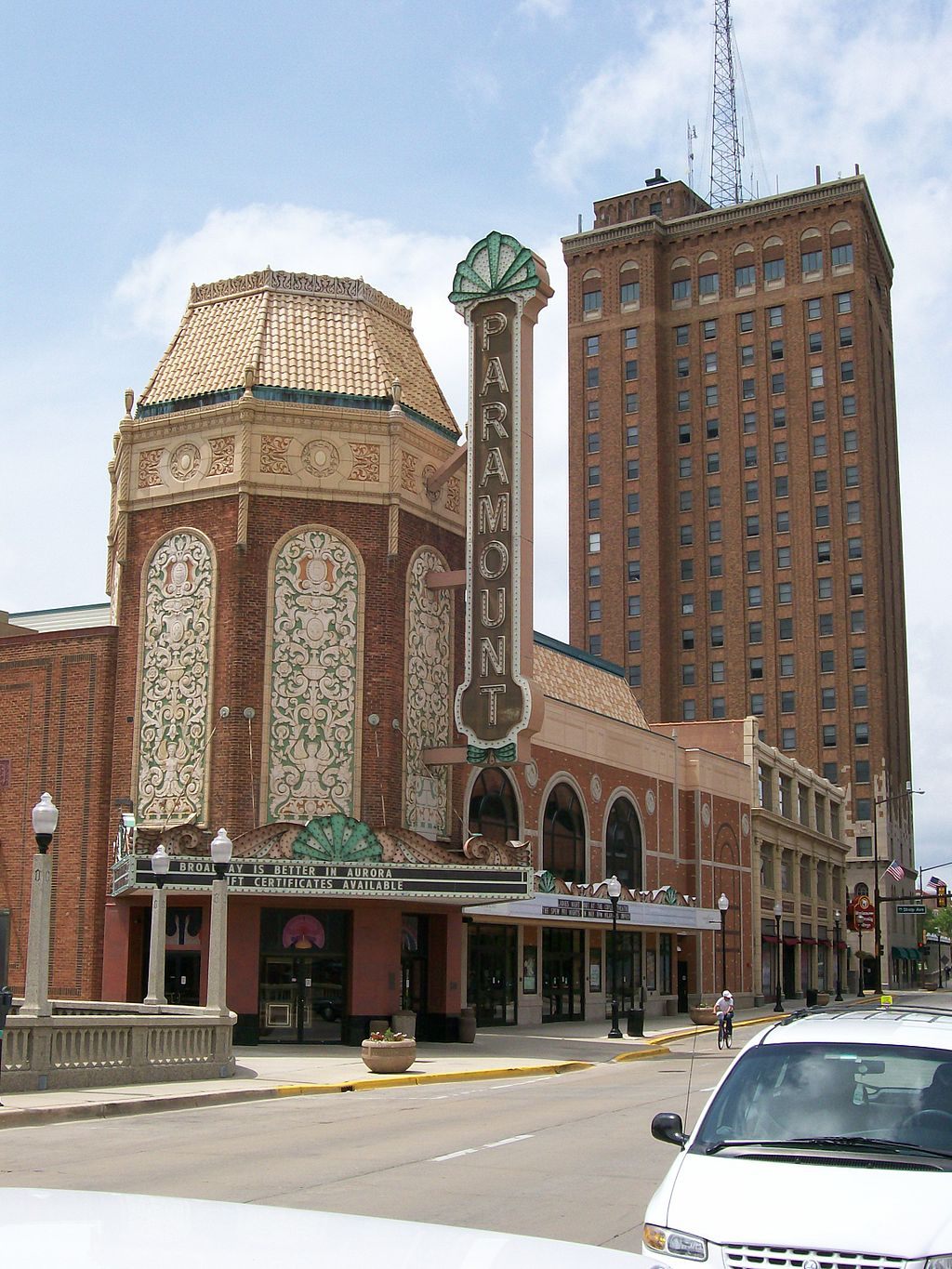 Paramount Theater (Photo by CBradshaw/Wikimedia Commons)
Paramount Theater (Photo by CBradshaw/Wikimedia Commons)
The Paramount was an early example of a series of theaters the Paramount Company intended to build in all American cities during the 1930s, before the Depression stalled their plans. Luckily, another company had already secured most of the funding for this Venetian-themed movie house, so Paramount only had to pay for the finishing touches (and a name change) before they were able to open The Paramount in 1931 with a lavish party featuring appearances from Jack Benny, Claudette Colbert, and The Marx Brothers.

The Paramount (Photo by Stephanie Barto/Flickr)
Throughout the Depression, the Paramount offered not only movies, but vaudeville, live theater, and circus acts, as well as then-novel air conditioning. The Paramount operated continuously until 1976, when it was granted National Landmark status and restored to its initial glory. Today it continues operation as a theater and movie venue, and has been named one of the top ten theaters in the greater Chicago Area. Movie history buffs can also sign up for guided tours of the venue.
BOONE COUNTY COMMUNITY BUILDING COMPLEX
Belvedire, Illinois
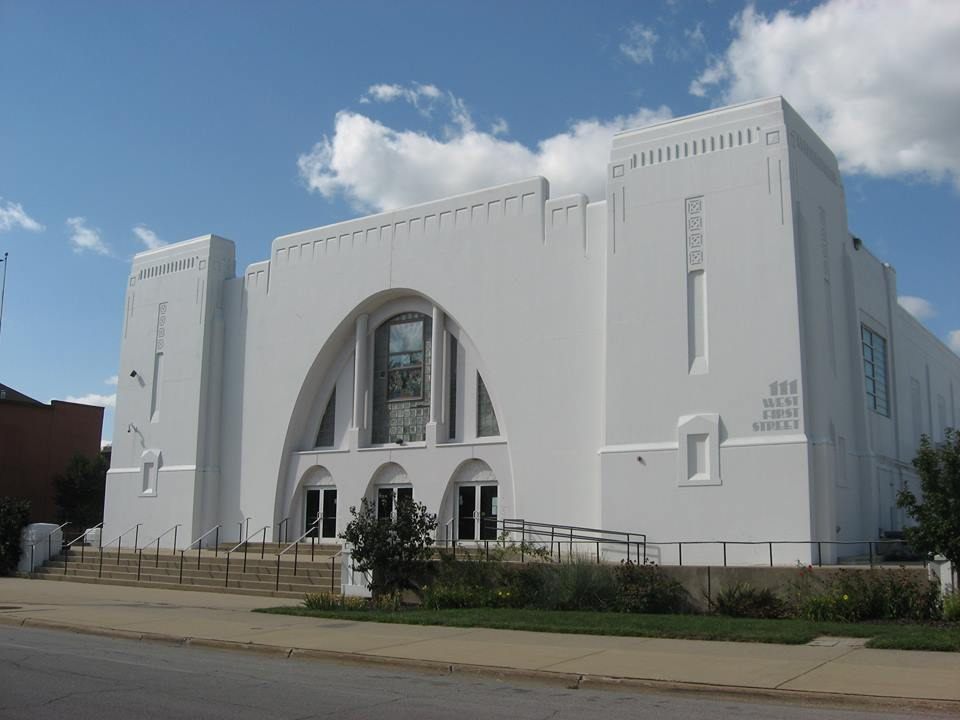 Boone County Community Building Complex (Photo by Community Building Complex of Boone County/Facebook)
Boone County Community Building Complex (Photo by Community Building Complex of Boone County/Facebook)
Attention, architecture buffs – this one location features not just one, but three distinct building styles, offering a mini-tour of early 20th-century Illinois design all in one place.
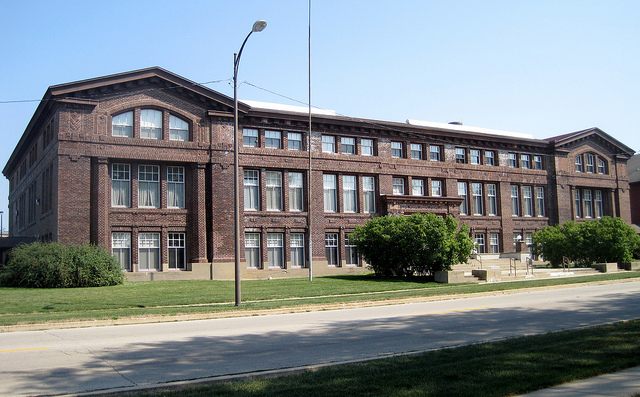
Boone County Community Building Complex (Photo by Teemu08/Flickr)
Originally the city’s high school, the main building dates to 1893 and features a Classical Revival style popularized by the 1893 Chicago Worlds’ Fair. Then in 1916, the school needed another wing – and used a Prairie School design. Ironically, the Prairie School was an architectural movement founded at the same Chicago Worlds’ Fair, favoring a simple style and handcrafted appearance; the Prairie School was developed by younger architects who felt that the Classical Revival was too ornate. In the 1930s, the school needed an auditorium; the Prairie School was out, and Art Deco was in. So the auditorium features an Art Deco design.
Today the building complex is a venue for concerts, meetings, and community sports and art events.
NATIONAL GUARD BUILDINGS
Cairo, Champaign, Delavan, Pontiac, Rockford, and Urbana (and Others)
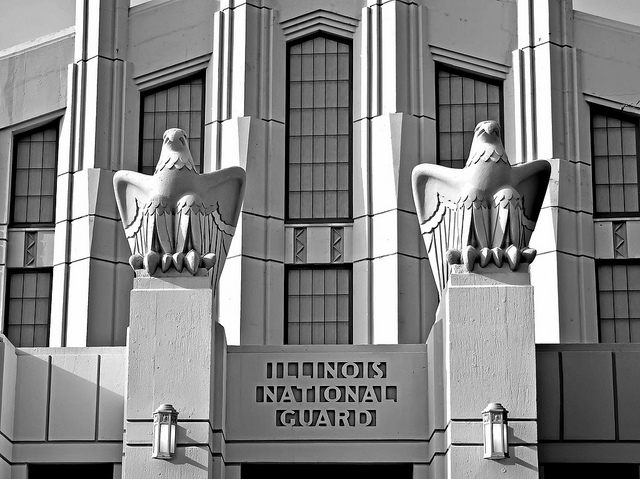
Delavan National Guard Armory (Photo by Douglas Coulter/Flickr)
One reason Illinois saw a surge in Art Deco design was because of the federal Works Progress Administration (WPA). This New Deal program offered millions of Americans relief from the Great Depression by employing them in public works projects like building roads or improving public parks. The WPA also funded several new public buildings – many of which in the then-current Art Deco style. Several Illinois cities got new National Guard armory buildings thanks to the WPA.
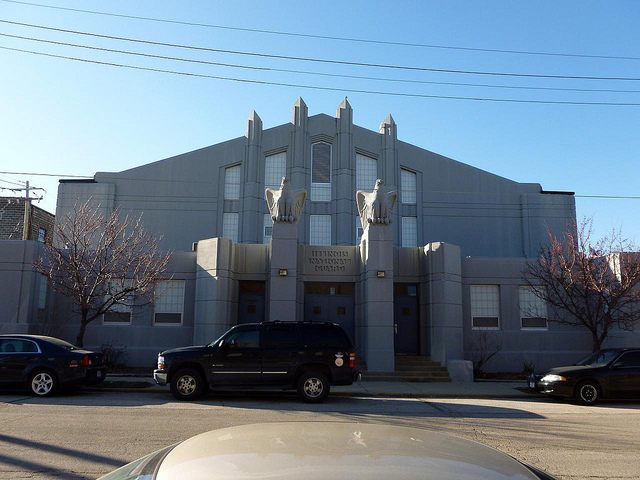
Champaign National Guard Armory (Photo by benjamin sTone/Flickr)
Some cities’ armories even shared the same design, first drawn up by Cook County architect S. Milton Eichberg. Eichberg’s armories are more reserved, as befits a military building, but still feature striking details like a pair of stone eagles flanking the main entrance. The design was striking enough for the city of Urbana to recently name their own armory one of the “100 Most Important Buildings” in town.
CAMPANA BUILDING
Batavia, Illinois
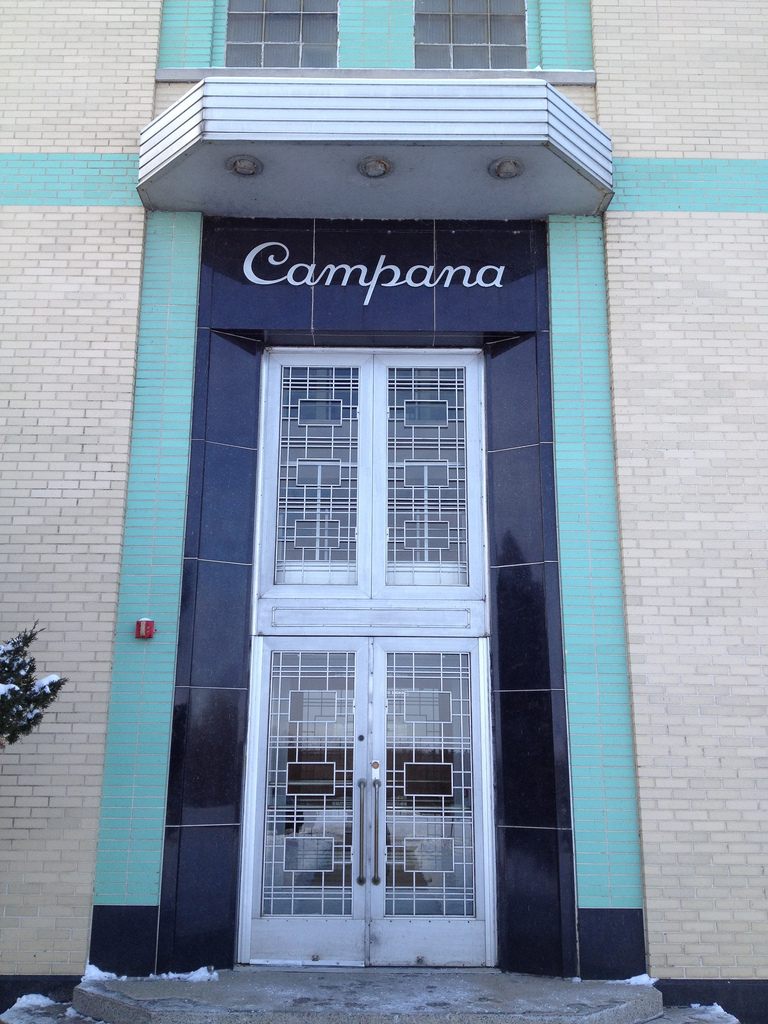 Campana Building (Photo by Pam Broviak/Flickr)
Campana Building (Photo by Pam Broviak/Flickr)
During the Great Depression, the Campana company was one of a very few industries enjoying economic success thanks to its popular “Italian Balm” hand lotion (and a very aggressive ad campaign). Campana was doing so well, in fact, that they needed to upgrade their factory in 1936.
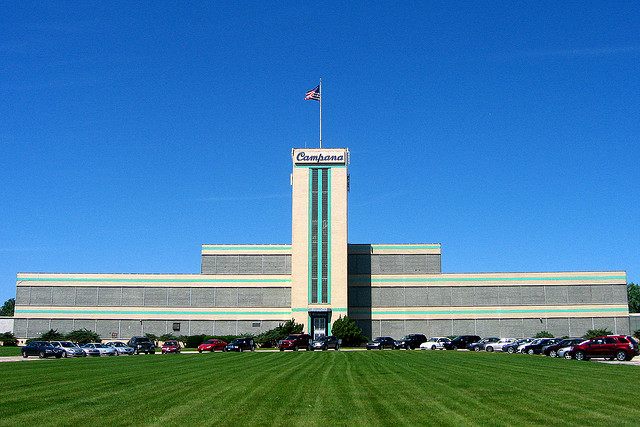
Campana Building (Photo by JohnPickenPhoto/Flickr)
The new factory was both designed to be functionally high-tech, as well as architecturally attractive. The building was three-stories tall, with a central tower rising 100 feet up to draw attention. The floors used glass bricks instead of windows, and filled the darker interior areas with fluorescent light and white tile. The entire building also boasted air conditioning for the workers’ comfort. The east wing had a “visitors’ gallery,” with a balcony and plate glass windows offering visiting investors a chance to watch the action on the factory floor without disturbing the workers.
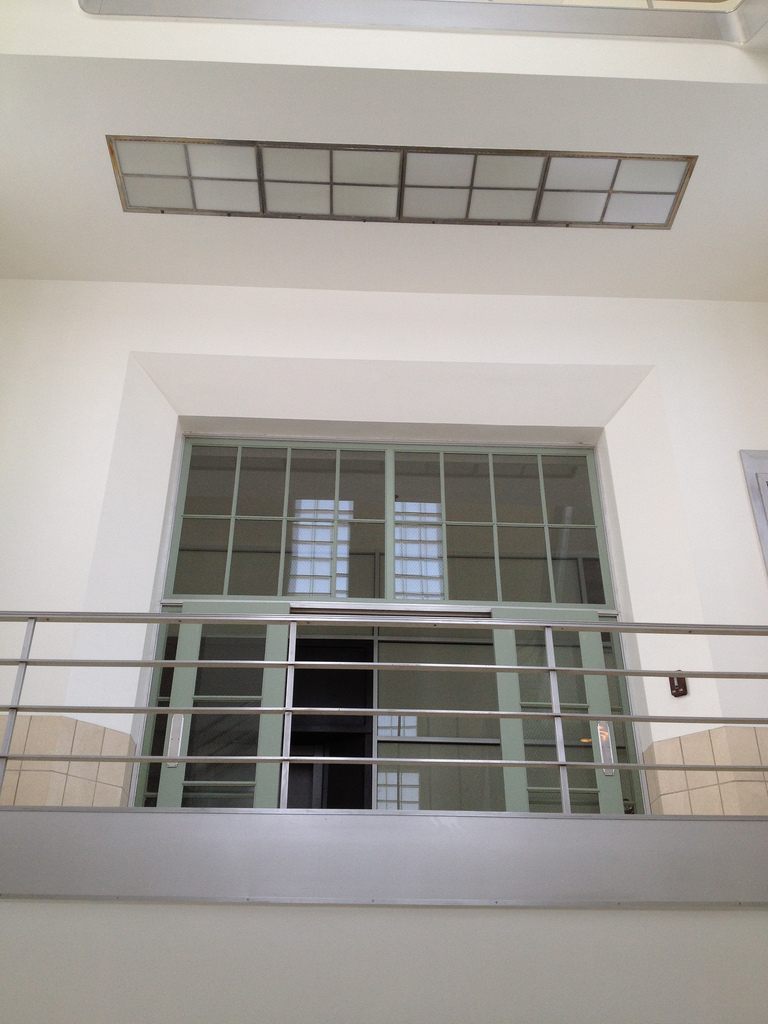 Campana Building (Photo by Pam Broviak/Flickr)
Campana Building (Photo by Pam Broviak/Flickr)
Campana was bought out by Dow Chemical in the 1960s, and the factory closed in the 1970s. Today the building is home to a costume rental facility, which proudly displays a picture of the landmark building on its web site.
ELGIN TOWER BUILDING
Elgin, Illinois
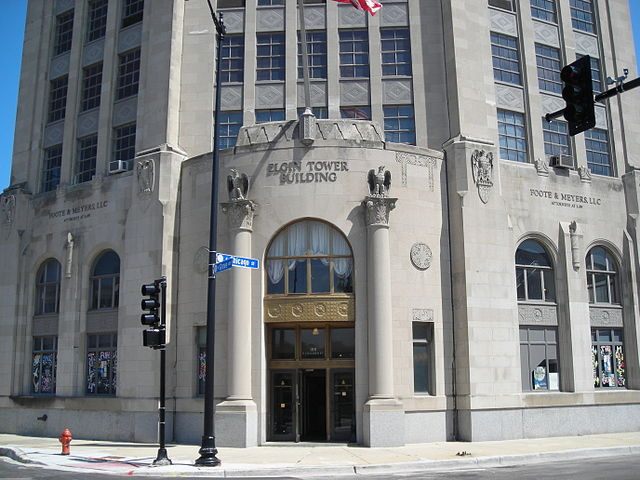
Elgin Tower Building (Photo by G Le Tourneau/Wikimedia Commons)
The city of Elgin enjoyed rapid growth through the 1800s, and was not yet 100 years old when it erected its first skyscraper – the Elgin Tower building, completed in May of 1929. Its main tenant was the Home National Bank, which installed state-of-the art bank vaults it claimed were both fire and burglar-proof; the Tower enlisted other local tenants over the course of that summer – and then the stock market crashed in October.
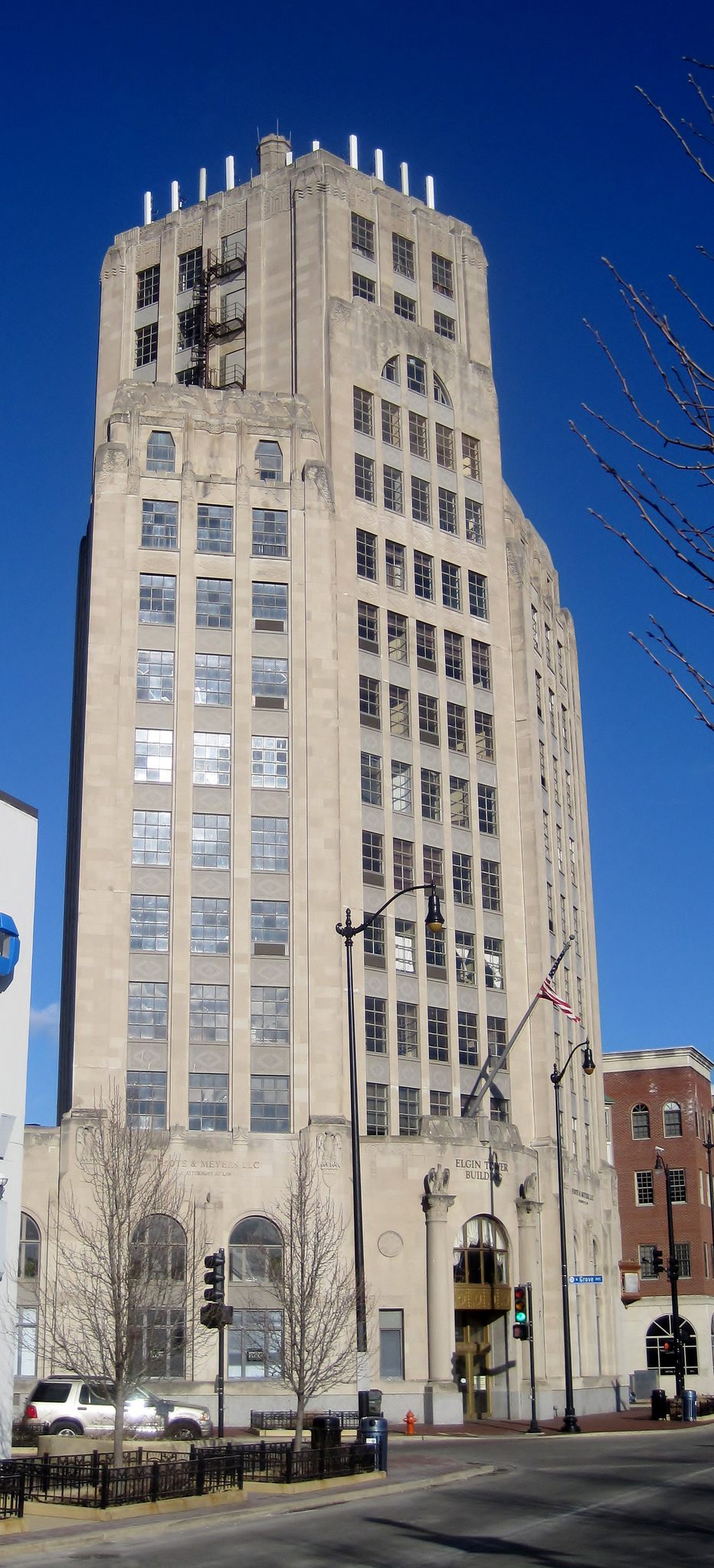 Elgin Tower Building (Photo by Teemu08/Flickr)
Elgin Tower Building (Photo by Teemu08/Flickr)
Home National Bank folded a couple years later, as did many of the Tower’s other tenants. The First National Bank of Chicago took over the building, and a ban on new construction in Elgin during the 1930s lead other new businesses to take up residence again, including a drug store on the main floor.
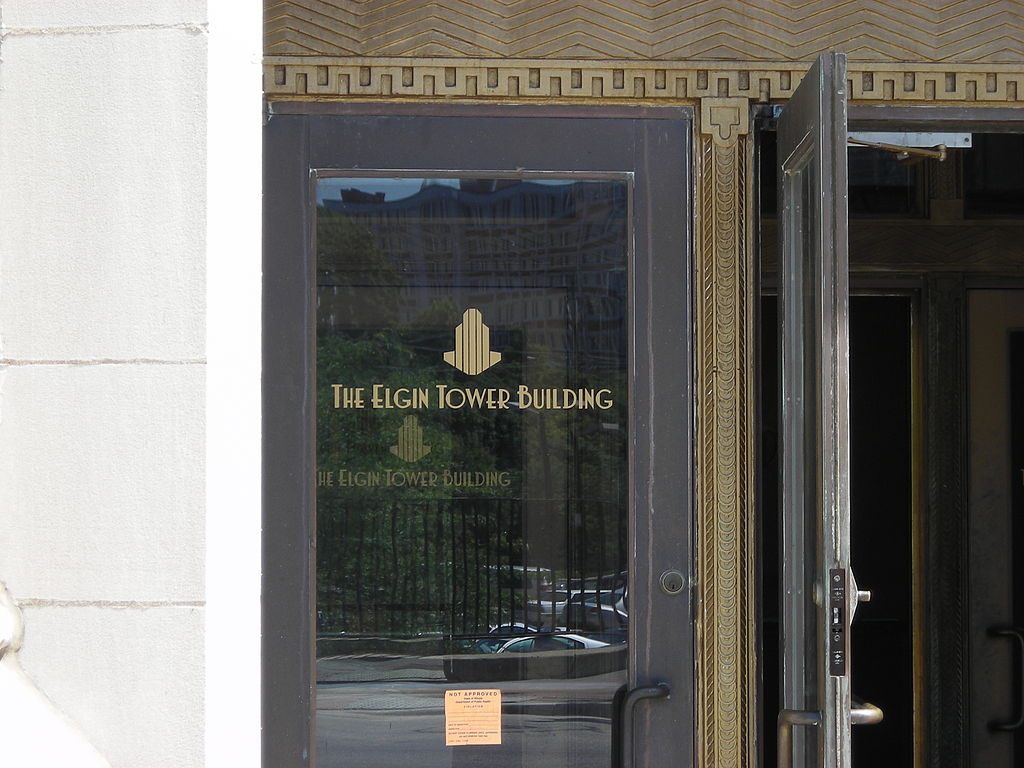 Elgin Tower Building (Photo by G Le Tourneau/Wikimedia)
Elgin Tower Building (Photo by G Le Tourneau/Wikimedia)
Elgin Tower’s luck has risen and fallen along with the town’s, but the building’s Art Deco design has stood out as a noteworthy exception to the rest of Elgin’s Victorian architecture, and it easily won landmark status in 2002. Today it houses Elgin’s Downtown Neighborhood Association.
EGYPTIAN THEATER
Dekalb, Illinois
 Egyptian Theater (Photo by Don Burkett/Flickr)
Egyptian Theater (Photo by Don Burkett/Flickr)
In addition to the influences Art Deco, 1920s and 30s architectural design had a brief obsession with Ancient Egypt, inspired by the 1922 discovery of the Tomb of Tutankhamen. Dekalb’s theater was one of over 100 movie houses using an Egyptian motif when it opened in 1929; however, only five such houses remain today, and the Egyptian is the only one east of the Rocky Mountains.
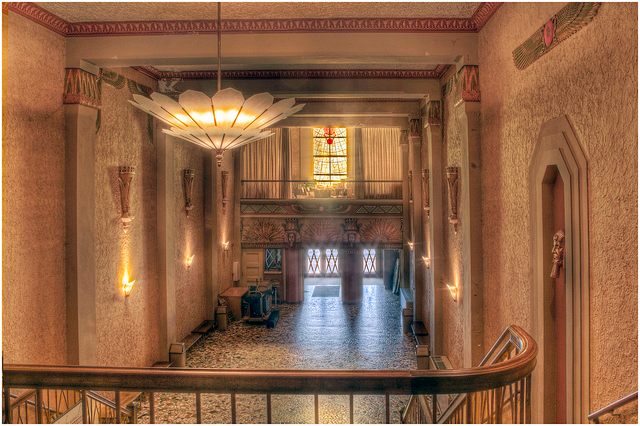
Egyptian Theater (Photo by Dave Putz/Connie Sieh/Flickr)
In its heyday the Egyptian was primarily a movie house with occasional live acts on weekends. After it closed in the 1970s, local movie fans rallied to take over the venue, restoring it to its original splendor and reopening it in 1983. The Egyptian has since housed live concert gigs from the likes of B.B. King, Lewis Black, REM, and The Violent Femmes, as well as weddings and community meetings; and, of course, the Egyptian still shows movies on the county’s largest screen.
CORONADO PERFORMING ARTS CENTER AND LIEBLING BUILDING
Rockford, Illinois
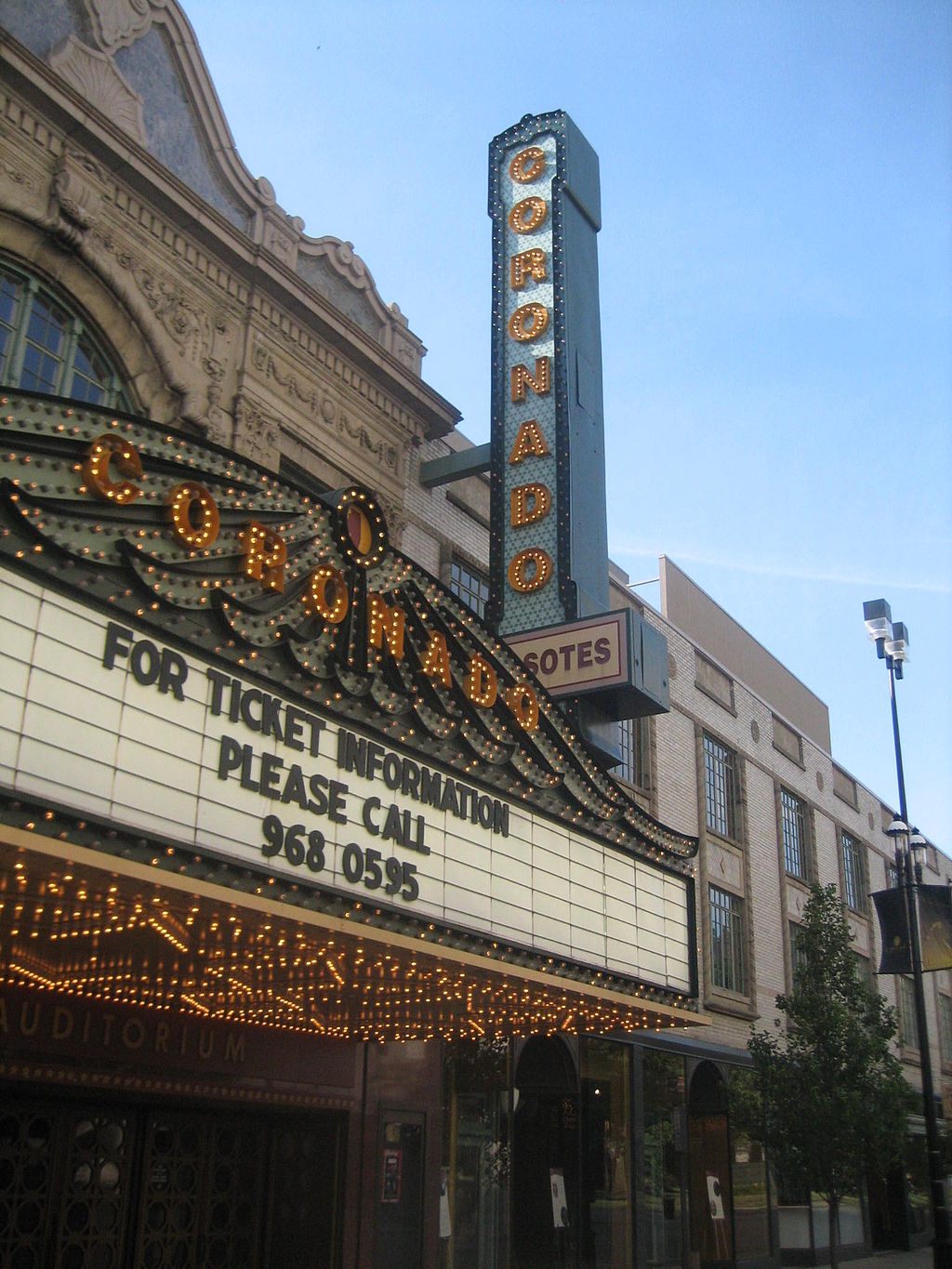 Coronado Performing Arts Center (Photo by Ivo Shandor/Wikimedia Commons)
Coronado Performing Arts Center (Photo by Ivo Shandor/Wikimedia Commons)
Where Dekalb went Egyptian, the Coronado went Spanish. The Coronado Theater was another lavish movie house from the 1920s, with an interior design meant to emulate an evening in a Spanish outdoor plaza – the walls were decorated to resemble Spanish building facades, complete with stained-glass lamps, and the ceiling was a deep blue festooned with “stars.”
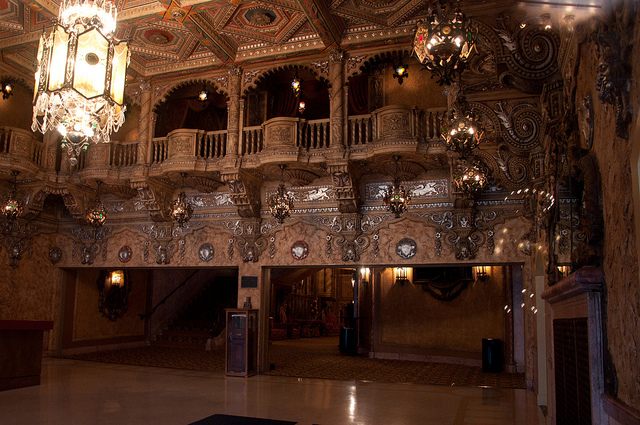
Coronado Performing Arts Center (Photo by vxla/Flickr)
It also featured occasional live acts amid its movie roster – Judy Garland, Bob Hope, and Frank Sinatra among them – but did away with movies in the 1980s and now serves as an all-live venue. However, it has preserved its original pipe organ from its early days as a silent movie venue; the Land of Lincoln Theater Organ Society, a separate entity devoted to theater organ preservation, offers occasional demonstrations on its use.
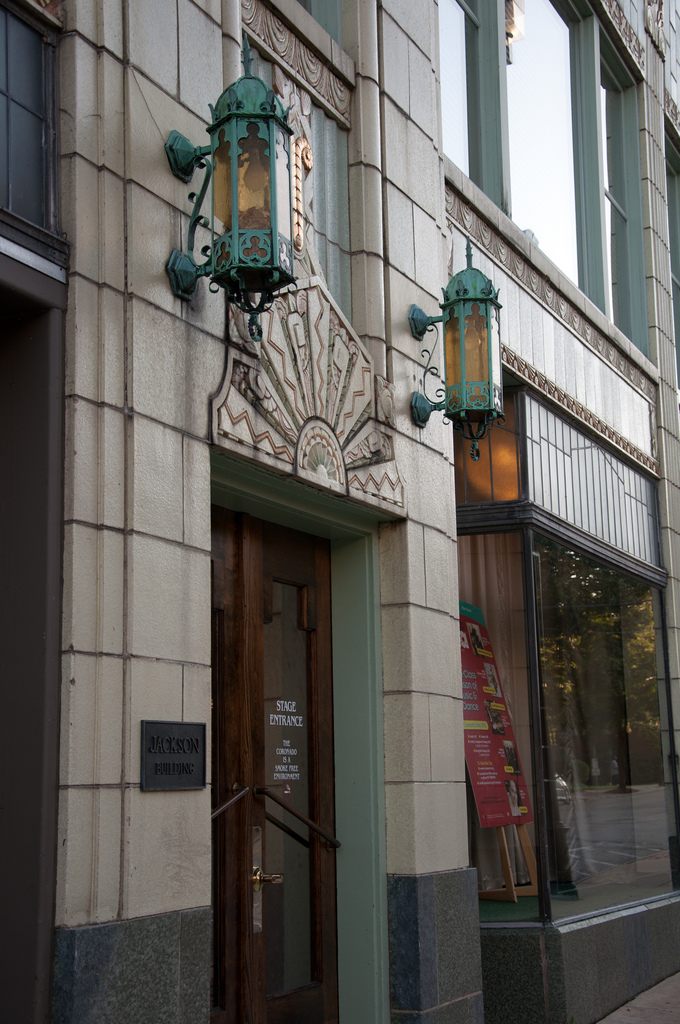
Coronado Performing Arts Center (Photo by vxla/Flickr)
Next door to the Coronado, the Liebling Building – also known as the “Jackson Piano Building” to locals – is another art deco building with a more mundane past as a nondescript office building. Today it’s home to the Coronado Center gift shop, but the Liebling’s façade is worth some attention as well.
ST. CHARLES MUNICIPAL BUILDING
St. Charles, Illinois
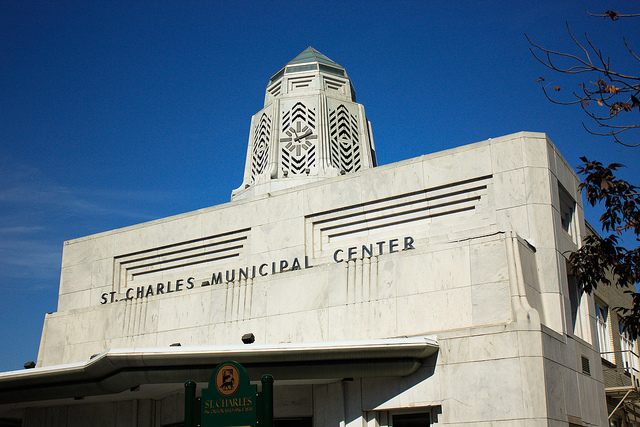
St. Charles Municipal Building (Photo by Bart Heird/Flickr)
In the 1920s and 30s, St. Charles enjoyed the patronage of a local benefactor – “Colonel” Edward J. Baker, a civic-minded fellow and heir to a barbed wire salesman’s fortune. Baker invested most of his wealth on general improvements to St. Charles, funding this new Municipal Building in the late 1930s.
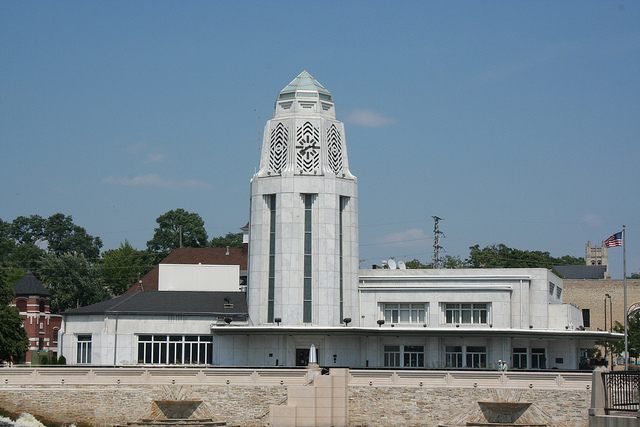
St. Charles Municipal Building (Photo by Daniel X. O’Neill/Flickr)
The building was meant to be a one-stop center for city business, and featured a bus station, city clerk’s office, police station, city council chamber, and offices for the mayor and the superintendent of public works. Baker also insisted on a wing devoted to museum displays on St. Charles’ industrial history. The interior design has been largely preserved since its opening in 1940. In 1998, the city added a mural to its exterior, depicting St. Charles’ town history.
PICKWICK THEATER
Park Ridge, Illinois

Pickwick Theater (Photo by BWChicago/Flickr)
Like other movie-and-vaudeville houses of the 1930s, the Pickwick featured an exotic motif – the main auditorium was designed to look like a Mayan temple.
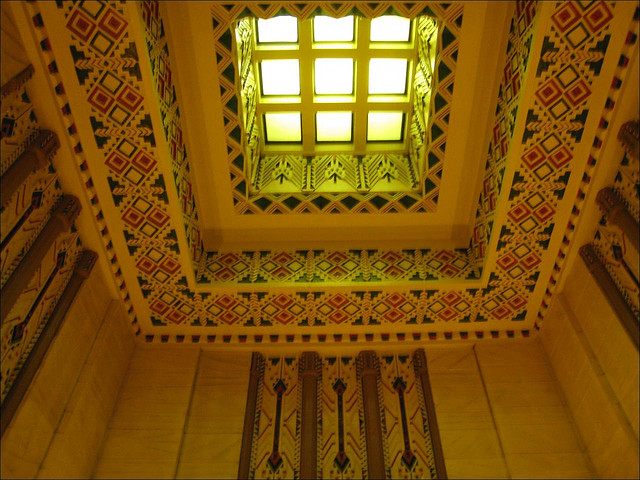
Pickwick Theater (Photo by BWChicago/Flickr)
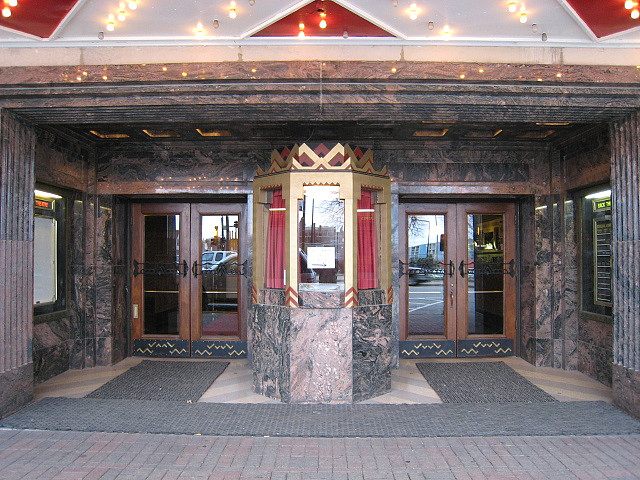
Pickwick Theater (Photo by BWChicago/Flickr)
However sharp-eyed movie fans may recognize the Pickwick’s marquee and ticket counter from the opening credits of the old review program, Siskel & Ebert & The Movies.

Pickwick Theater (Photo by Kelly Martin/Wikimedia Commons)
Illinois Week on Atlas Obscura was created in partnership with Enjoy Illinois as part of the launch of the new Illinois Obscura Society. Sign up to find out more about the back room tours, unusual adventures, and incredible parties that Atlas Obscura will be putting on in Chicago and greater Illinois.



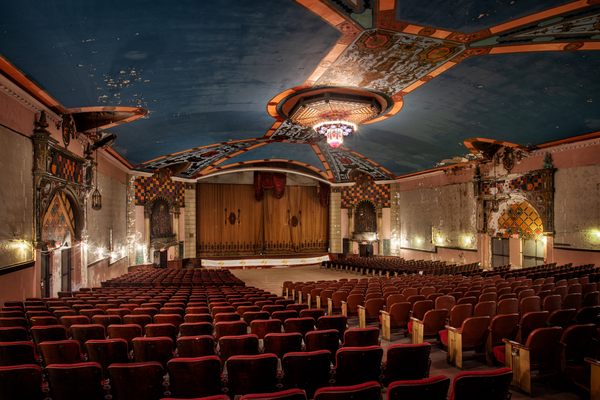














Follow us on Twitter to get the latest on the world's hidden wonders.
Like us on Facebook to get the latest on the world's hidden wonders.
Follow us on Twitter Like us on Facebook